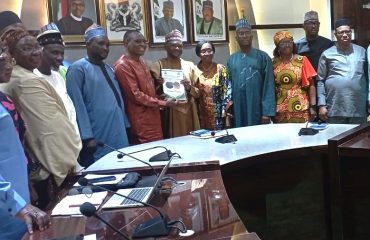ABU partners CIEGRAM, FUGA and UMD to convert plant along Hadeja Irrigation Channels
Communities along the Hadeja Irrigation Channels in Jigawa State can now be rest assured that their economic status would soon receive an uplift as a project to convert Typha grass to Biogas and animal feed and, thereby, better their agricultural productivity and income is underway. This is so because Ahmadu Bello University, Zaria is currently in collaboration with four other institutions in Nigeria, Spain and USA to not only eradicate this age-long menace to agricultural productivity in Hadejia valley, but also convert the ‘destructive’ grass to an economic-boosting ingredient for people along that axis.
On 4th to 6th July 2017, a contingent of the collaborators from CIEGRAM (Spain), FUGA (Gashua, Nigeria) and UMD (USA) arrived NAERLS, Ahmadu Bello University, to strategize on the project. The team comprised Dr Eva Iglesias and Professor Fernando Escribano (both of CIEGRAM), as well as their counterparts in Nigeria, led by Professor James Adeosun (of NAERLS). To begin with, the team was led by NAERLS Director, Professor Muhammed Khalid Othman on a courtesy visit to the Vice Chancellor, Ahmadu Bello University, Professor Ibrahim Garba, in his office. While receiving the team, the Vice Chancellor, who was ably represented by the Deputy Vice Chancellor (Academics), Professor Ezekiel Amass, reiterated the University’s resolve to better the economic life of Nigerians through strong collaborations and partnerships. He spoke of his academic efforts in the area of typha grass eradication, especially along the Hadeja Irrigation Channel and quipped that he is delighted that the University is in partnership to finally and completely eradicate the ‘stubborn grass’ and, by the same process, convert it to an economic opportunity for the people.

There was a call for proposal in one of the Nigerian dailies sometime in September 2015 on the eradication of Typha grass along the Hadeja Irrigation channel (in Kano State) and conversion of the plant to biogas and animal feed. NAERL (Nigeria) collaborated with CIEGRAM (Spain) to develop and submit a robust proposal to this effect. The two main objectives of the project are to: eradicate typha plant that reduces irrigation activities along the Hadeja Irrigation channels through mechanical harvester; and convert the harvested plant to biogas and animal feed in order to improve the livelihoods of the community along the irrigation channel.
In the course of developing the proposal, it became expedient that two other institutes needed to be co-opted into the collaboration. These are the University of Maryland, USA (UMD) and Federal University, Gashua (FUGA). According to the Terms of Reference of the contract, CIEGRAM is the principal investigator; NAERLS is responsible for the development of the Typha harvester, as well as the conversion of the plant to biogas; FUGA is to develop silos for silage storage, and also for the conversion of the plant to animal feed; UMD is to develop the microbes expected to catalyse the decomposition or breaking down of the plant. A part of the partnership also is that selected staff of NAERLS and FUGA shall be sponsored for postgraduate studies (MSc and PhD) to CIEGRAM and UMD.

The project team paid a two-day visit to Hadeja Irrigation channels to abreast itself with the current situation vis-à-vis the strategy on ground.


